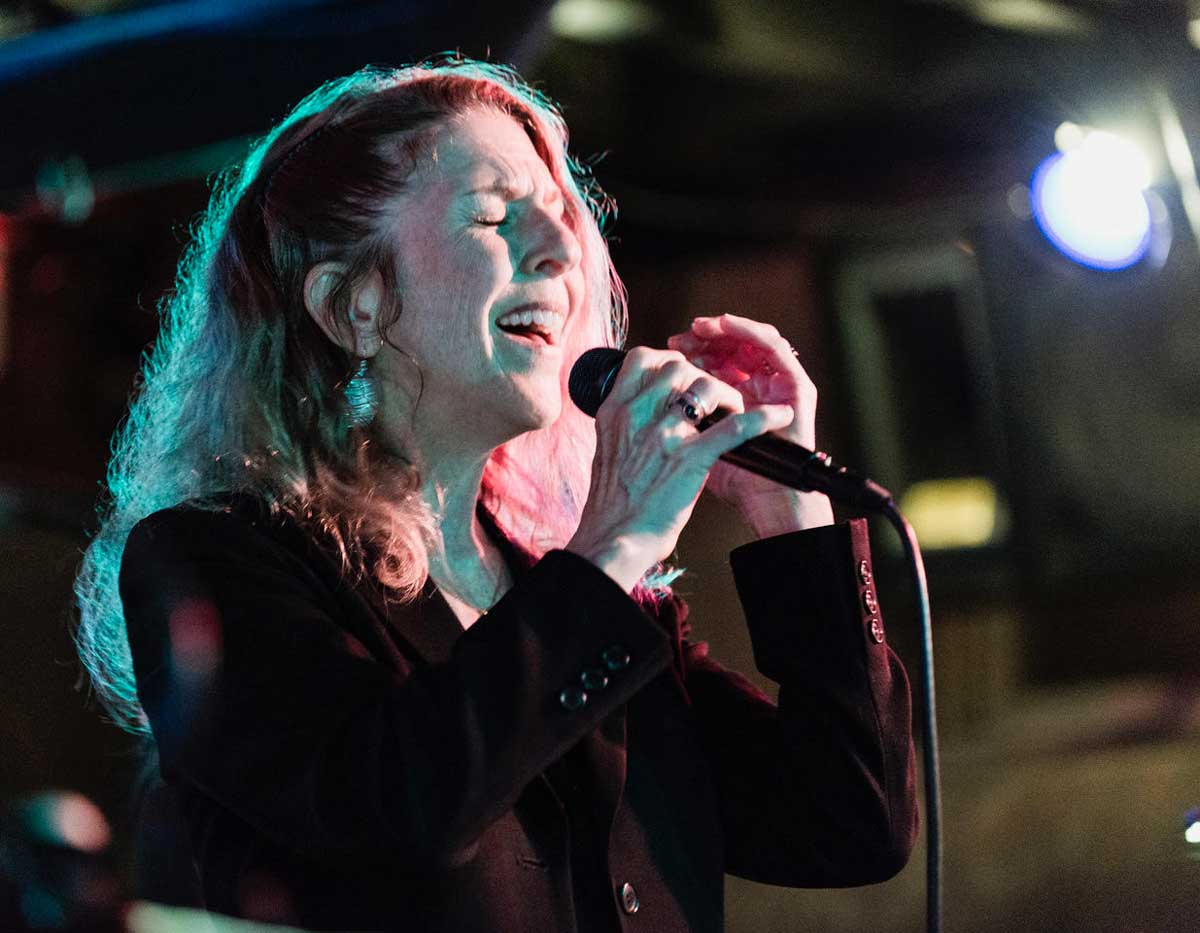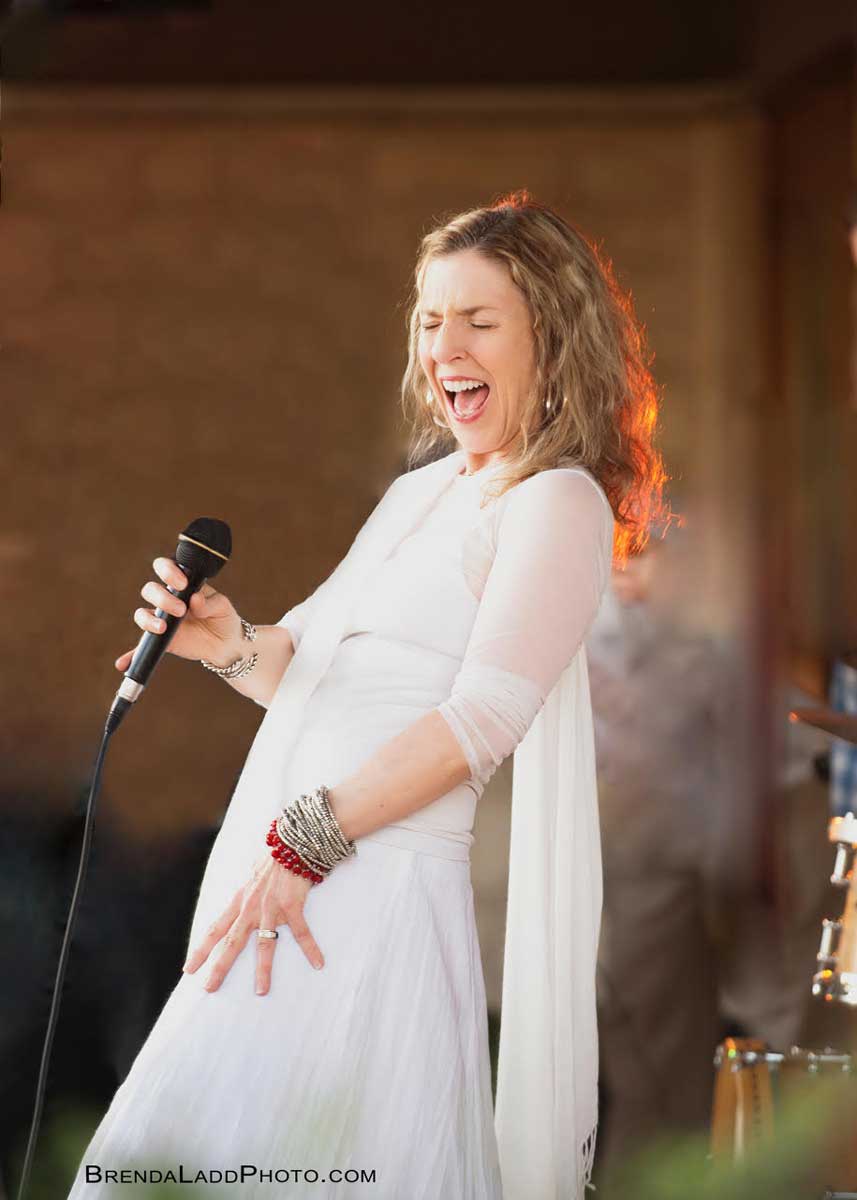As a vocalist, Suzi Stern has a long inside view of the jazz scene in Austin. She has found it rich and intense since she came there in the 1970s, she says, and sometimes unexpected — singing Leonard Cohen tunes in the middle of Texas, with people drinking Shiner beer and doing the two-step and eating nachos. (Her bandmates went on world tours with Cohen, Bill Guinn on keys, Mitch Watkins on guitar, Roscoe Beck on bass and Paul Ostermayer on saxophone.)
Later she was giving house concerts with her husband, jazz pianist George Oldziey, and musicians from the city and across the country gathered in their living room, from Puerto Rican bassist Eddie Gomez to Texas and New York singer Roseanna Vitro.
“There are power spots on the earth where inspiration is pulled out of you,” Stern said.

Jazz vocalist Suzi Stern performs in an outdoor concert at night. Press photo courtesy of the artist
This spring, she is about to be inducted into the Texas Music Hall of Fame, and from her new home in Lenox, she is planning to bring Austin jazz to the Berkshires.
Originally from Buffalo N.Y., she has lived many years in Texas, and her road back to the Northeast has taken many turns. Austin became the city where her children were born, she said, and through shifts and changes of life, she has kept many friends there.
Three years ago, she and Oldziey moved to Los Angeles, following currents in his career. He is a jazz pianist and a composer of film scores, and her longtime accompanist — he performs in her jazz quintet, as she performs in his Latin jazz band. They were setting up new community in Southern California, she said, when Covid hit. And the pandemic changed their sense of professional geography.
‘There are power spots on the earth where inspiration is pulled out of you.’ — Suzi Stern
“He was doing film work from a room in Pasadena and talking with colleagues in Vienna and Rome,” she said. “So why live in L.A.? And California was burning down. We had seen maybe five days of rain in four years.”
They were thinking about moving to a place more environmentally clean, she said. She missed the sounds of water and trees in the wind. Then George began teaching at the Berklee Music School in Boston a couple of days a week.
In Lenox, house finches lighted on the bush outside the kitchen window, the males already in deep red-orange plumage for the spring, reminding her of the seasons and birds she knew as a child.

Jazz vocalist Suzi Stern performs, smiling.
“We have a little Big City and then this,” she said, gesturing to their quiet street a mile from downtown Lenox. “We feel blessed. We love the neighbors and the neighborhood.”
In the months since they came here, she has been exploring the jazz scene around her, meeting presenters and musicians and composers, from Ed Bride, president of Berkshire Jazz, to bassist Andy Wrba, founder of the Berkshire Jazz Collective.
Meetings like these have stirred her plans to bring a festival to Lenox that she has been curating in Austin for 10 years with jazz pianist and composer Peggy Stern (no relation but an old friend). They call the celebration Lulufest, named for the classic standard Lulu’s Back in Town. And Suzi Stern plans to bring a new rendition here this summer (July 15 at Shakespeare & Co.).
The festival celebrates women as bandleaders and composers with their own artistic projects, she said, as she recalled performers they have brought to Texas — Ingrid Jensen on trumpet, and Helen Sung, one of her favorite jazz pianists — and Sara Caswell, who will come here this summer to perform on jazz violin.
Plenty of men are also involved, she said, in the bands, on bass and drums and piano and more. But women take the lead and offer their own vision of the music. Women as musicians come in with different perspectives, she said, and in jazz she feels they rarely have room to be heard.
‘Women as musicians come in with different perspectives, and in jazz they rarely have room to be heard.’
She sees the difference between scrambling for a part as a side player in a big band, where all the songs are written by a hard-driving guy telling his stories — and performing her own work to tell her own.
Stern remembers seeing that difference visibly for the first time. She was 18 or 19, she said, the when she saw an art installation by sculptor Judy Chicago. Chicago had started in monolithic soldered and welded metal, to compete with her contemporaries, but as soon as she could find support for the work she wanted to do, she moved into ceramics. She created compositions around a table, outrageous, bold forms that draw on women’s bodies and experiences.
“It changed how I thought about my role in the arts,” Stern said. “Women have a story to tell.”

Jazz vocalist Suzi Stern belts out a high note.
She considered powerful events in her own. Her children’s births have run through her music and changed the energy of her singing, she said, and she recalled music that has moved her deeply because it speaks in some close, intuitive sense to her life.
“My favorite composer in jazz is Marie Schneider,” she said. “Her Sky Blue — I can’t listen to it without crying.”
Stern’s recent work also takes on a more intimate note. In her latest album, Romancing the Dark, she sets her own words to music, her own compositions, arrangements and lyrics. Over the years, she said, she has published lyrics to many jazz classics and contemporary works by some of the great instrumentalists and composers — John Coltrane, Miles Davis, Mal Waldron, Bill Evans, Joe Henderson, Joshua Redman, Denny Zeitlin.
“Instrumentalists often don’t write lyrics,” she said. “They think of their music as a more open palette for listeners to infuse with their own stories.”
Shaping an album of her own poems gave her a way to bring voice to songs she is passionate for, she said. She would talk with the composers to make sure they felt her words respected and reflected their music.
She also teaches music rarely sung today, she said. One of her students, Chelsea Chiu, won the 2022 best jazz vocal soloist student award at Downbeat, a gold standard for the jazz community, she said, with Miles Davis’ Four and Seven Steps to Heaven, and a ballad by Bill Evans, Time Remembered.
Stern wants to create platforms and programs for musicians to perform, she said — whether they’re emerging or touring nationally and well-known in the genre, they face challenges in connecting with the people who want to hear their music.
‘(In Covid) we’d get together masked … — we’d be outside with a keyboard and an amp and an extension cord on someone’s front lawn — and we couldn’t believe the reactions from our neighbors.’
With the rise of digital platforms, she said, listeners often don’t know how much goes to the technology and how little to the performers.
“I put up some of my music on Spotify and Pandora before I knew how little I’d get back for it,” she said — “I get these hilarious ‘royalty’ checks for 0.0001 cent, for I don’t know how many streams.”
And at the same time, Covid taught her how hungry people were for the music.
“We’d get together masked in California,” she said — “we’d be outside with a keyboard and an amp and an extension cord on someone’s front lawn, and we couldn’t believe the reactions from our neighbors. They would bring picnics and fill the street. They were starved for music — and it was joyous (to feel their energy).
“I’ve always known how important music and art are to people’s well-being, but to see someone put a hundred in the jar with tears in their eyes …”

Jazz vocalist Suzi Stern belts out a high note.
The last three years have reinforced for her the power of performing live. In the pandemic, she joined in a sea of serial recordings across distance, like a patchwork sculpture of music. She can create the form of a song that way, she said — have the guitar play through the lead 12 times, send it to the bass player to listen and record over the top, map out a bass solo here, a saxophone solo here … But that kind of isolation leaves a hollow, especially in a form that lives on improvisation.
“It’s not like playing live,” she said. “You can’t have the conversation in the moment … when you’re singing with musicians, breathing with them, responding to them.”
She would miss the challenge and inflection between the sax and the piano — the spontaneous building energy when the bass takes a shape off the drum and so does the voice.
As the world stirs to life again, she hopes jazz is moving, in a way, toward its roots. This genre is born from people making music together in the hardest times, she said. Jazz musicians have always found ways to play and to learn.
She thought of the force and patience of that drive, the way her husband would listen to records as a boy, slowing them down to transpose a few bars, lifting up the needle and resetting it to listen again — or a trumpeter would sit in the alley behind a club and listen to Charlie Parker as the sound of his solos carried outside.
Her husband talks with his students now, she said, about that energy and excitement. She and he have found that sometimes musicians with new technology in their hands will try to cut through that practice. Composing improvisationally in electronic and computerized music is a very different practice, she clarifies, and often innovative and improvisational. She is concerned with the effects she sees in using tools like Chat GBT. When musicians ask a computer to do their thinking or listening or composing for them, for her the short-cuts show.
“People are using AI to lie about it,” she said — “and you can tell. … You can only get into that focused zone if you do it yourself. If you do everything with a computer and copy-and-paste, you’ll never get into that creative place.”
And for her it’s infinitely worth taking the time, to know how it feels to ride the wavelength in making her own music — an endorphin high like running, and an emotional high like intimate conversation, like dancing.
“You (find) a phrase you love,” she said, “you (hear in your mind) a chord progression you’ve never heard before … and you feel so good.”


Hi Suzi,
Please put me on your email list. Will you be doing something at the Stagecoach – Sunday Jazz Brunch???
Hi Glenn, are you looking for jazz vocalist Suzi Stern? We’ve enjoyed writing about her, and she’s planning a jazz festival in Lenox in July. You can find more about her on her website, linked here, and you can sign up for the BTW Berkshires newsletter on ours, for a weekly roundup of, music, theater etc. Thanks very much!